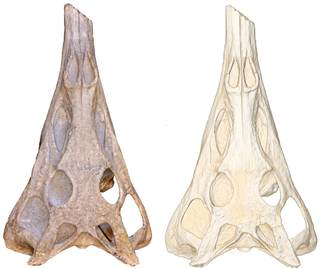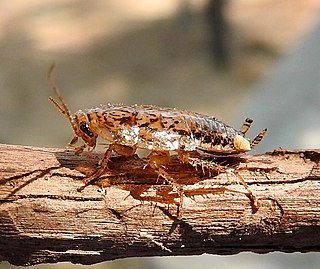
Paleorhinus is an extinct genus of widespread basal phytosaur known from the Late Triassic. The genus was named in 1904 based on the type species Paleorhinus bransoni, which is known from Wyoming and Texas in the United States. Another valid species, Paleorhinus angustifrons from Bavaria, Germany, is also commonly referred to the genus. Paleorhinus had a length of about 2.5 meters.

Parasuchus is an extinct genus of basal phytosaur known from the Late Triassic of Andhra Pradesh and Madhya Pradesh, India. At its most restricted definition, Parasuchus contains a single species, Parasuchus hislopi. Parasuchus hislopi is one of several species belonging to a basal grade of phytosaurs, typified by the genus Paleorhinus. Historically, Paleorhinus has been known from better-described fossils, and many species have been lumped into that genus. Parasuchus hislopi, despite being described earlier than Paleorhinus, was considered an undiagnostic chimera until new neotype fossils were described in the late 1970s. Parasuchus hislopi and the two unambiguously valid species of Paleorhinus are all closely related; some authors have historically described them all under the species Paleorhinus, while others place the two Paleorhinus species into Parasuchus according to the principle of priority.
Gastrotheca angustifrons is a species of frog in the family Hemiphractidae. It is found in Colombia and Ecuador. Its natural habitats are subtropical or tropical moist lowland forests and rivers. It is threatened by habitat loss.

The russet-backed oropendola is a species of bird in the family Icteridae. It is found in wooded habitats in the highlands of the northern and central Andes and the Venezuelan Coastal Range, and in lowlands of the western Amazon. It is generally common and widespread. Males are larger than females, but otherwise the genders are similar. Its plumage is mainly olive and brown, and the outer rectrices are contrastingly yellow. The lowland nominate subspecies has a black bill, while the highland subspecies all have pale bills. These have been regarded as separate species, but as they hybridize freely, all major authorities now regard them as a single species.

Haplochromis angustifrons is a species of cichlid endemic to Uganda where it is found in Lake George, Lake Edward and the Kazinga Channel. This species reaches a length of 9 centimetres (3.5 in) SL.

The Tanganyika lates is a species of lates perch endemic to Lake Tanganyika. It is a widespread predator on other fishes. This species can reach a length of 200 centimetres (79 in) SL and the greatest recorded weight is 100 kilograms (220 lb). This species is important commercially and is also popular as a game fish. It is threatened by the pressures that these activities put upon the population.

Ebrachosuchus is an extinct genus of basal phytosaur known from the Late Triassic of Bavaria, southern Germany. It is known only from the holotype BSPG 1931 X 501, a complete skull missing both mandibles. It was collected at Ebrach Quarry, bed number 9 from the late Carnian-aged Blasensandstein Member of the Hassberge Formation. It was first named by Oskar Kuhn in 1936 and the type species is Ebrachosuchus neukami.

The southern spotted skunk is a species of mammal in the skunk family, (Mephitidae). It ranges from Costa Rica to southern Mexico. At one time this skunk was considered to be a subspecies of the eastern spotted skunk.
Scalenodon is an extinct genus of traversodontid cynodonts from the Middle Triassic of Africa and possibly Russia. The type species S. angustifrons was named in 1946 and several other species were named in the following years. Most of the species from Africa are now thought to belong to different genera than Scalenodon.
Mandagomphodon is an extinct genus of traversodontid cynodonts from the Middle Triassic Lifua Member of the Manda Beds of Ruhuhu Valley, Tanzania. The type species Mandagomphodon hirschsoni was named by Crompton in 1972 as a species referable to Scalenodon. Later studies, including a 2003 phylogenetic analysis of traversodontid relationships, did not find the species of Scalenodon from the Manda Formation to form a single clade, meaning that many were not referable to the genus. The study suggested that S. hirschsoni had more in common with other traversodontids like Luangwa. S. attridgei was viewed as a possible synonym of S. charigi, which was also found to be only distantly related to S. angustifrons. Therefore, a new generic name Mandagomphodon was erected for S. hirschsoni by James A. Hopson in 2013.

Gobionotothen is a genus of marine ray-finned fishes belonging to the family Nototheniidae, the notothens or cod icefishes. They are native to the Southern Ocean.
Drycothaea angustifrons is a species of beetle in the family Cerambycidae. It was described by Breuning in 1943. It is known from French Guiana and Ecuador.
' Paragus angustifrons, the Narrow-faced Grass Skimmer, is an uncommon species of syrphid fly observed throughout North America. Hoverflies can remain nearly motionless in flight. The adults are also known as flower flies for they are commonly found on flowers from which they get both energy-giving nectar and protein-rich pollen. The larvae have been reared from Aphis spiraecola and Aphis spiraephila.

Latiblattella is a genus of cockroach in the family Ectobiidae.

Stenocatantops is a genus of grasshoppers in the family Acrididae and subfamily Catantopinae. The recorded distribution of species includes: India, China, Indo-China and Malesia through to Australia.
The South American worm lizard is a worm lizard species in the family Amphisbaenidae. It is found in Argentina, Paraguay, and Bolivia.

Horistonotus is a genus of beetles belonging to the family Elateridae.

Stenocatantops splendens is a species of short-horned grasshopper in the family Acrididae. It is found in Indomalaya and eastern Asia.

Bovichtus angustifrons, the dragonet, horny, horny thornfish, marblefish, thornfish or variegated marblefish, is a species of marine ray-finned fish, a temperate icefish or thornfish, belonging to the family Bovichtidae. It is endemic to southeastern Australia and Tasmania on rocky reefs in shallow waters.

Stenocatantops mistshenkoi is a species of short-horned grasshopper in the family Acrididae. It is found in eastern Asia.















